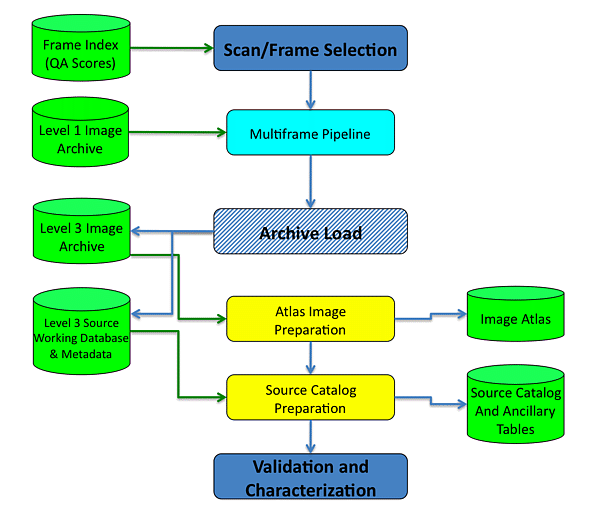


V. Atlas and Catalog Generation
1. Overview - From Image Archive and Source Working Database to Image Atlas and Source Catalog
Generation of the Image Atlas and
Source Catalog for the
WISE All-Sky Data Release, characterizing their properties,
and producing this Explanatory Supplement was done during the
Final Product Generation (FPG) phase of
WSDS data processing.
The elements of the FPG process are illustrated in Figure 1.
Input for FPG is the archive of calibrated Single-exposure (L1) images,
the database of detections from those images, and metadata and quality
assessment produced during Scan/frame processing. The ensuing steps
of FPG are:
- Scan, Tile and Frameset Selection - The first step in the FPG process
selects the subset of Single-exposure (L1) data that will be
combined during Multiframe processing.
Scan selection is driven
primarily by the scope of the data release, and defines the
spatial boundaries of the Atlas Tiles
that will be included in the Release. The subset of Single-exposure (L1)
framesets and band-frames in those scans that are the input data for
the Multiframe processing is driven by the achieved quality of the individual
Single-exposures (L1) as assessed during the Scan/frame data
QA process.
Scan and frameset selection
are described in V.2
- Multiframe Processing - Although the
Multiframe pipeline (IV.3.c) is functionally part
of the
WSDS PIPELINES subsystem, operationally it is
run during the FPG process. Multiframe processing combines the
Single-exposure images that were identified during the Scan/frameset
selection step, and builds coadded (L3) Images on
Atlas Tile footprints.
Sources are detected on the coadded images, then characterized using
both the coadded images and the individual Single-exposure images that
contribute to the coadds. Multiframe processing produces
Image Sets for each Atlas Tile that contain the calibrated Intensity Images,
Depth-of-coverage maps, and Uncertainty maps, and a list of extracted sources.
These are compiled and stored in the L3 Image Archive and Source
Working Database (WDB).
- Atlas Image Preparation - For the WISE All-Sky Release,
the L3 coadded images produced by the Multiframe pipeline processing are
identically the served Atlas Images. No further modification of the images,
their headers, or image metadata was performed following the Multiframe
processing.
- Source Catalog Preparation - The All-Sky Catalog Preparation step
selects the subset of entries in the L3 Source WDB that constitute a
complete and reliable Source Catalog, and performs final formatting
of those columns for the Release. In addition to detections
of real astrophysical sources, the L3 WDB produced during Multiframe
processing contains spurious detections of low SNR noise excursions,
image artifacts, and residual transient events such as cosmic rays, hot pixels,
satellite streaks and scattered light that were not completely removed by
the outlier rejection step in the image coaddition procedure. The WDB
also contains duplicate detections of sources that fall within the
overlap regions between Atlas Tiles. Catalog source selection
filters out low reliability spurious detections from the WDB using criteria
based on SNR, artifact flagging, frame-detection statistics
(V.3), and selects one apparition of
duplicate detections (V.3.c) for appearance
in the Source Catalog.
- Validation and Characterization - The final step of FPG
is the analysis of the Release Atlas and Source Catalog to
assess their characteristics, validate product integrity and
quality, and verify performance. The results of these analyses are documented
in in section VI.
Output from the WSDS FPG steps consists of the All-Sky Release
Image Atlas,
Source Catalog, the ancillary
products described in I.2.c,
and this Explanatory Supplement.
 |
| Figure 1 - Final Product Generation Functional Flow |
Last update: 2012 March 16










